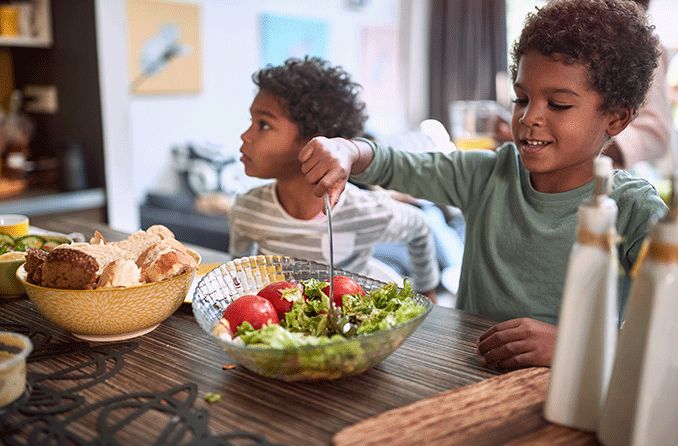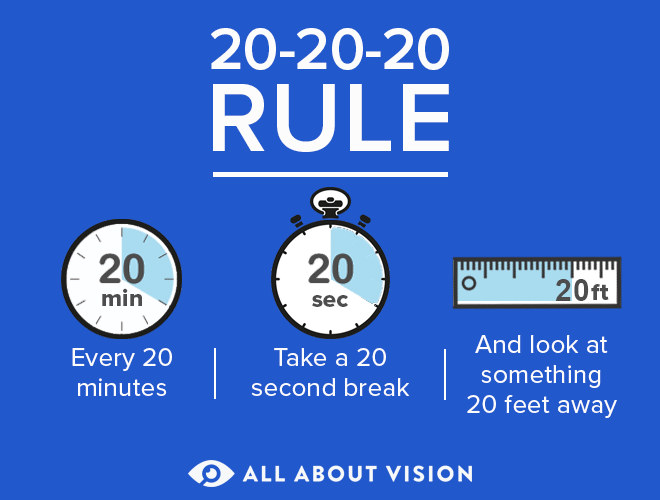What are the healthiest eye habits for kids?

Healthy eye habits for kids
You teach your kids that it's important to eat right, get outside, move around and get a good night's sleep. But what can they do to keep their eyes in good shape? From limiting screen time to wearing protective eyewear, here's a list of healthy eye habits for kids that you can put in place today.
Eat for eye health
Did your mom or dad tell you to eat plenty of carrots for good vision? Well, it turns out carrots are just one of the foods that promote eye health. Get your kids in the habit of eating a healthy diet that includes a rainbow of fruits and vegetables, including:
Avocados
Beans
Citrus fruits
Sweet potatoes
Leafy greens
You can also add healthy protein sources such as:
Eggs
Coldwater fish
Lean meat
Poultry
Sunflower seeds
Eating healthy is great for your overall health and your eyes.
READ MORE: How better nutrition can improve your vision
Stop rubbing your eyes
Many kids naturally rub their eyes when they're sleepy, and you may even think it's cute. But some children rub their eyes because of itching from allergies or the feeling that there’s something in their eye.
Unfortunately, rubbing the eyes is not a good habit because it can cause:
Eye infections – Touching the eyes with contaminated (germ-covered) fingers can lead to eye irritation and infections like pink eye, which is common in children.
Eye damage – Rubbing the eyes too hard over time can even damage the corneas, which may result in a condition known as keratoconus.
Get your kids to practice keeping their hands away from their eyes and face. If they have allergies that cause itchy eyes, try artificial tears or antihistamine eye drops such as Children’s Alaway (ketotifen).
Proper and frequent hand-washing is a must as it will limit the spread of eye infections in kids.
Limit screen time
It's a big challenge for parents, but teaching your kids to limit screen time can help their eyes. Excess screen time has been linked to myopia development, eye focusing and eye-teaming issues.
If your kids are little, start them out with good habits by instilling daily screen time limits and making mealtimes and bedrooms screen-free zones. If your kids are older, talk about the benefits of limiting screen time and create a family screen time plan.

Teach kids of all ages to take screen breaks to lower the risk of digital eye strain using the 20-20-20 rule:
Look away from the screen every 20 minutes
Focus on something at least 20 feet away from you
Keep your eyes on that object for 20 seconds
Make the 20-20-20 rule easy for your kids by getting them in the habit of setting a timer for 20 minutes whenever they start using a device with a screen. When the timer sounds, they can get up, move around, go look out the window or even focus on a favorite picture or object across the room.
SEE RELATED: Screen time recommendations by age
Do fun activities to strengthen vision
Did you know that focusing on eye health can be fun? One way to prevent damage to your kids' vision: Find fun things to do that will provide their eyes a break from digital screens. Here are some activities to help with kids' vision development as recommended by the American Academy of Ophthalmology (AAO):
Get creative with drawing or painting
Make necklaces or bracelets by stringing beads
Put together jigsaw puzzles with lots of small pieces
Play a game of catch outside with a nerf-type ball
These activities offer a mix of exercise for the eyes and may also help kids develop good hand-eye coordination that will serve them later in life.
READ MORE: Advantages of a 24-hour digital detox for kids
Spend time playing outside
Playing outside is another good way to promote kids’ vision development — it allows a child to get away from screens and relax their visual system.
Spending an extra half-hour or so outside each day may even lower their risk of developing nearsightedness (myopia). And it's part of an overall healthy lifestyle, which is important for good eye health.
Here are a few ideas for outdoor activities you can do with your kids for eye health:
Go on a neighborhood walk
Hold a scavenger hunt
Take a family bike ride
Play with sidewalk chalk
Fly a kite on a windy day
Start a backyard garden
See the sights in your area
Pick apples or berries at a local orchard or farm
Go stargazing on a cloudless night
Make sure your children wear high-quality sunglasses for kids when spending time outside during the day. Sun damage builds up over time, so making it a habit to wear 100% UV-blocking sunglasses is one of the best things you can do for your kids.
READ MORE: Celebrate Healthy Vision Month
Protect your eyes during sports
If your child plays sports or has other active hobbies, make sure they use protective eyewear for kids. The AAO states that eye injuries are the top cause of blindness in children, and nine out of 10 of these injuries could have been prevented with protective goggles.
Kids should wear protective sports eyewear made from polycarbonate (shatterproof) lenses for any activity where there's a risk of eye injury, including:
NERF gun battles
Archery
Baseball and softball
Basketball
Hockey
Paintball
Lacrosse
Racquetball
Soccer
Snowboarding and skiing
Swimming
If you’re worried your kids won't be interested in protective eyewear, work with their eye doctor and optician to show them all the options that will offer the right protection and fit. Then let them pick out the color and style.
Sports eyewear comes in an array of fun colors and looks so kids can have fun and feel cool while keeping their eyes safe.
READ MORE: Features to consider when purchasing sports glasses for kids
Make regular eye doctor visits
Make a point to check in on your child's eye health regularly and watch for signs of common eye problems in kids, including:
Covering an eye
Eye misalignment
Avoiding up-close activities like reading and homework
Looking too closely at books or screens
Losing their place frequently while reading
Turning their head to look at something in front of them
Finally, make sure to schedule regular comprehensive eye exams for your child. Vision issues like myopia, eye-focusing and eye-teaming issues are becoming more common in kids and regular eye checks can help ensure any vision problems are detected and corrected early. Plus you'll get your child in the habit of visiting the eye doctor as part of an eye-healthy life.
READ NEXT: Questions to ask your child’s eye doctor
36 fabulous foods to boost eye health. American Academy of Ophthalmology. January 2020.
How to make a family media use plan. American Academy of Pediatrics. November 2020.
Screen use for kids. American Academy of Ophthalmology. June 2021.
Vision development: Childhood. American Academy of Ophthalmology. August 2020.
20 things to know about children's eyes and vision. American Academy of Ophthalmology. December 2019.
Page published on Tuesday, February 15, 2022
Page updated on Thursday, April 28, 2022
Medically reviewed on Tuesday, February 8, 2022






